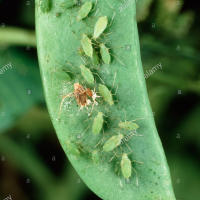Pea aphid
Acrythosiphon pisum
Field peas, alfalfa and clovers are the main hosts of the pea aphid (Acrythosiphon pisum). Other legumes, including lentils, fababeans, vetches, sweet clover, sweet peas, trefoil and dry beans are also hosts.
Adult pea aphids are soft-bodied, slow-moving, and range in colour from light to dark green. They are pear shaped, about 3 mm (1/8 in.) long and 1.5 mm (1/16 in.) wide, with long slim legs. The antennae of the pea aphid show narrow dark bands at the tip of each segment. The nymphs are smaller but closely resemble the adults.
Pea aphids overwinter as eggs on leaves and stems of perennial legumes (ex, on the crowns of clover or alfalfa). In the spring, when plants resume growth, a small, light green, wingless female hatches from each egg. These aphids, which are all females and are called "stem mothers", can reproduce without mating. They feed on the growing plants and give birth to female young. Some aphids of the second and third generations become winged and migrate to field peas and other acceptable host plants. There they feed and produce wingless females that give rise to winged and wingless females.
Aphids develop from birth to maturity in 5 to 50 days depending on the weather. The optimum temperatures for rapid development of pea aphids range from about 23 - 28ºC. All pea aphids are female throughout spring and summer. A summer female can produce 50-150 young during her life. If the host crop is cut during spring or summer, the winged aphids leave to search for new plants on which to live.
In late September or October, winged males and wingless females are produced. These mate and the females lay eggs on leaves and stems. There may be seven to 15 generations per year.







Plant Protection Products
- ⭑⭑
- N/A
- N/A
- N/A
- N/A
- N/A